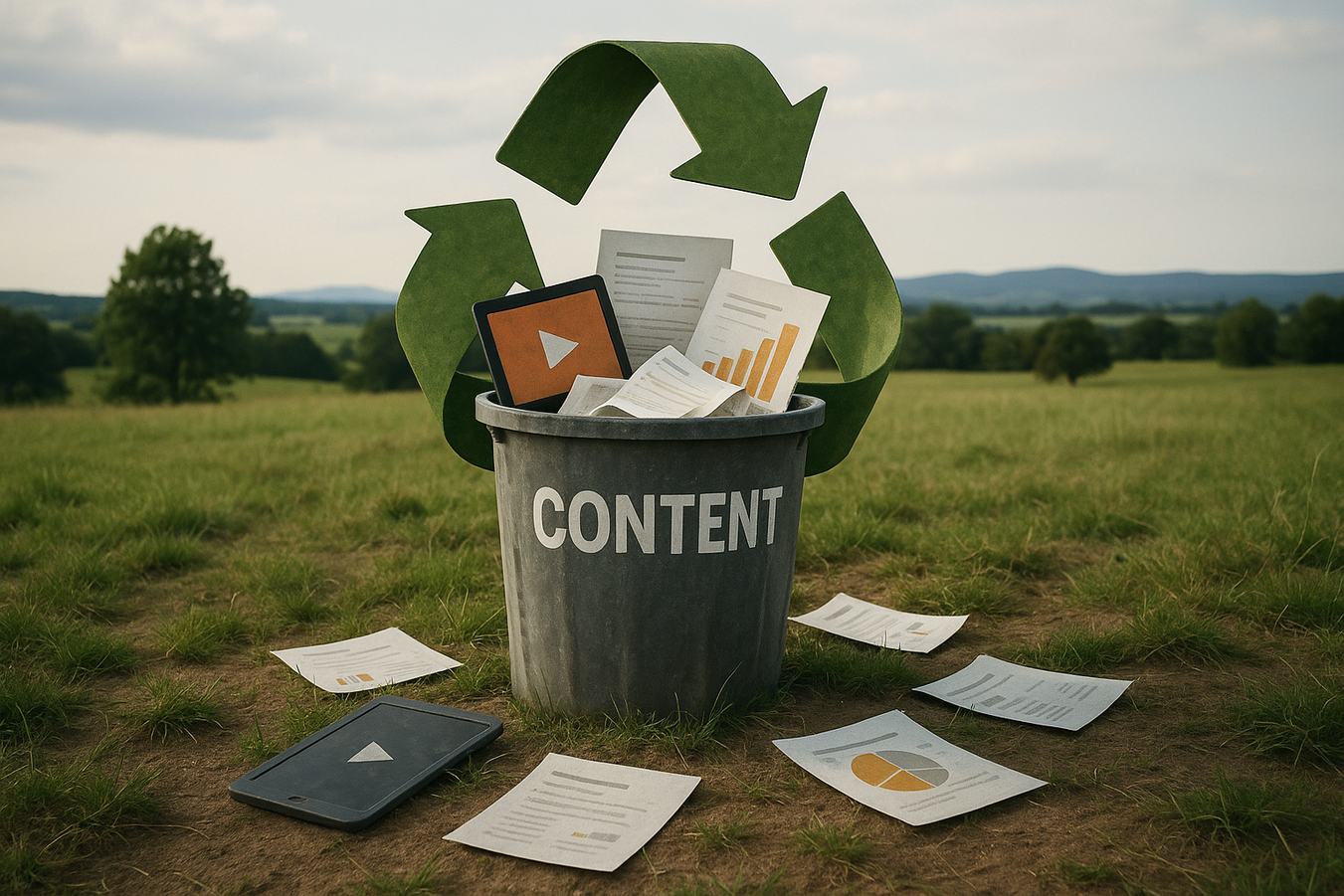Let’s face it, today’s marketers are stuck in a never-ending loop of creating new content just to stay visible. Blogs, videos, carousels, infographics… it feels like you’re on a treadmill that’s only getting faster. But despite the grind, most of that effort barely moves the needle on actual results. It is exhausting, expensive, and often unsustainable. That’s why smart marketers are stepping back and rethinking the whole approach. Instead of chasing “new,” they’re focusing on getting more from what’s already been created. Circular content strategies, which involve repurposing, refreshing, and redistributing content, help you stretch the value of every asset across platforms and formats. The result? Better-performing evergreen content, smarter resource allocation, and a noticeable boost in marketing efficiency. It is not about working harder, it is about working sharper.
Understanding Circular Content Strategy and Marketing Efficiency
What Is Circular Content Strategy?
Consider the cyclic content strategy as the distinction between investing in a classic wardrobe piece and purchasing hasty fashion. Traditional marketing frequently involves creating content, posting it, and then forgetting about it. A circular strategy, on the other hand, views each piece of content as an asset rather than a one-time waste. It is not about becoming busy; it is about becoming wiser. Instead of that exhausting “create–publish–move on” cycle, circular content strategy works like a loop. You build strong core content once, say a detailed blog post, a video explainer, or a whitepaper, and then keep spinning new value out of it. That blog can become multiple social posts, an emailer, a podcast topic, or even a short video script. You optimise it, adapt it to different platforms, update it over time, and keep it relevant. Suddenly, one piece of content has legs that can run a marathon. This approach creates what you might call a content ecosystem. Every bit of content feeds into something else. It is a network, not a line. And the longer that network runs, the more value you extract from your original work. That’s how you shift from just producing to actually strategising, and that’s where marketing efficiency gets a real upgrade.
Why This Strategy Supercharges Marketing ROI
Without outcomes, strategy is meaningless; let’s discuss the numbers. The fact that circular content lowers your content development expenses is one of its greatest benefits. Teams can improve on what currently works rather than continuously starting from scratch. As a result, more time will be spent optimising rather than thinking. The outcome? Smarter, leaner processes that save money and effort.The surprising thing is that repurposed content frequently performs better than original content. Why? Due to its battle-tested nature. Your audience’s preferences, clicks, and attention-grabbing content are already known to you. You are no longer speculating. You’re getting better. Every new edition or format of your content that builds on previous success is more relevant, more targeted, and has a higher conversion rate. The ripple effects are huge. Businesses that implement circular content strategies report up to 40–60% reduction in content creation costs, while also seeing a 200–300% increase in reach. That’s not fluff;; it’s real efficiency translating into tangible growth. And best of all, your team gets to spend less time churning and more time thinking strategically, researching audiences, improving SEO, and refining performance metrics. It is not about doing less. It is about doing what works, again and again — just smarter every time.
The 5 Proven Content Strategies for Maximum Marketing Efficiency
Strategy 1: Content Repurposing and Recycling
Modern marketers aren’t running out of ideas, they’re just drowning in formats. You write a great blog post, and then what? It lives on your site, gets a couple of clicks, and then disappears into the archives. That’s the real waste. Repurposing flips this cycle. It is not about lazily copy-pasting — it is about extracting more value from content that’s already proven itself.
Start with High-Performers
Not all content deserves a second life; only the best does. Start by identifying your top performers:
- Content with strong engagement (likes, comments, shares)
- Posts that drive traffic or conversions
- Articles that continue to get organic reach over time
These become your “parent content”, the base for everything that follows.
Now imagine this: one blog post about 2025 marketing trends becomes a 3-slide carousel for LinkedIn, a voice-over video reel, a few tweetable insights, and a section in your next newsletter. That’s the magic of repurposing, one idea, many formats, multiple wins.
Adapt for Each Platform (Don’t Just Reuse- “Reimagine”)
Different audiences hang out on different platforms, and they expect different things:
- On LinkedIn, you might turn the blog into a sharp industry insight post.
- On Instagram, you break it into a visual story or a casual explainer reel.
- For YouTube Shorts or Reels, distil your message into bite-sized value bursts.
It is all about changing the tone, format, and pace, not the core message. You’re not creating new content, you’re shaping the same clay in new moulds.
Streamline with Systems
The most efficient content teams don’t repurpose as an afterthought — they build it into their workflow. They:
- Plan repurposing while creating original content
- Use templates for quote cards, carousels, or videos
- Set publishing timelines across platforms to stagger release and extend content life
Over time, this builds a rhythm where one blog fuels a week’s worth of marketing without draining your team.
Strategy 2: Evergreen Content Creation
In a world where content gets outdated before your coffee cools down, evergreen content is your marketing life raft. It is the kind of content that stays useful and relevant long after it is published, the FAQs, how-tos, and resource guides that don’t go out of style with every trend or algorithm change. Think of it as your brand’s long-term investment, slow to start, but built to last.
Why Evergreen Content Matters
Unlike trend-chasing content that spikes and then flatlines, evergreen content performs like a steady engine.
- Generates consistent organic traffic over months (and sometimes years).
- Continues to convert leads long after the initial campaign is over
- Becomes a library of value that your audience can rely on.
In other words, while everyone else is busy making noise, evergreen content quietly builds trust, visibility, and ROI on autopilot.
What Makes Content “Evergreen”?
Not all content qualifies. Evergreen content needs to be timeless, useful, and universally relevant. Ideal formats include:
- Step-by-step tutorials (e.g. “How to Set Up Google Analytics”)
- Beginner’s guides and explainers on core industry concepts
- FAQs, troubleshooting tips, or how-to videos
Lists of tools, best practices, or foundational strategies. These are the kinds of topics people Google today, next month, and even a year from now. If your content can answer those questions clearly and reliably, you’re in evergreen territory.
Keep It Fresh Without Reinventing
Now here’s the trick: Evergreen doesn’t mean “set it and forget it.” To stay competitive in search rankings, you’ll need to:
- Update stats or tools mentioned in the piece
- Refine the intro, title, or headers for better clarity or SEO
- Add internal links to newer, related content
But don’t worry, we’re not talking about constant overhauls. A quick review every 3–6 months is usually enough to keep things sharp and relevant.
Evergreen content isn’t about going viral. It is about being reliable. It is the digital version of compound interest, a small, consistent value that grows over time. When done right, this kind of content becomes a quiet powerhouse in your strategy, delivering results while you sleep.
Strategy 3: Content Optimisation for Multiple Platforms
Wherever you travel, it is crucial to speak the language, not just to be present. Publishing the same content across platforms could appear cost-effective, but in reality, it is like wearing the same outfit to a gym, a beach party, and a business meeting. Your content faces the risk of being ignored if it doesn’t adapt to the expectations, pace, and tone of each platform.
Achieving true multi-platform optimisation requires more than just decreasing captions or image sizes. Understanding the true motivations behind each channel is crucial. This includes understanding why users use it, how they interact with the content, and what prevents them from surfing.
Know Where Your Audience Hangs Out, and How They Behave
It starts with research, not assumptions.
Before you optimise anything, figure out:
- Where does your audience spend time (Instagram, LinkedIn, YouTube)
- What kind of content do they engage with on those platforms
- How they interact, likes, comments, shares, saves, clicks?
This information helps you focus your efforts and create material that seems authentic rather than like it was copied and pasted from another source.
Optimise for the Platform, Not Just the Feed
Each platform has its own “rules of the game.” To win, your content needs to:
- Use headline styles that trigger curiosity (on platforms like LinkedIn or YouTube)
- Incorporate emotionally driven copy and engagement cues (on Instagram or Facebook)
- Be hashtag smart — don’t overuse them on LinkedIn, but go strategic on Instagram
- Align with format preferences — Reels on Instagram, carousels on LinkedIn, threads on X
You’re translating your message so that it sounds natural wherever it ends up, not just making formatting adjustments.
Timing and Frequency Matter (A Lot)
Another secret weapon? Timing. Each platform has its sweet spot:
- Instagram engagement spikes during lunchtime and late evenings
- LinkedIn is all business — weekdays, early hours
- X (Twitter) performs better with high frequency and breaking content
- YouTube benefits from weekend drops when users binge-watch
Without paying more money, you may significantly boost visibility and engagement by matching publishing to audience behaviour.
Intelligent multi-platform optimisation is a continuous practice rather than a one-time solution. Your data-driven adjustments create a more intelligent content engine over time when user preferences and algorithm changes occur. One that not only appears, but does so in the appropriate location, at the appropriate moment, and with the appropriate voice.
Strategy 4: Strategic Content Planning and Batching
You’re not alone if creating content seems like a never-ending treadmill. It is not only exhausting but also incredibly inefficient to jump from idea to idea, write last-minute articles, and chase deadlines. In this case, batching and content preparation are helpful since they provide a more systematic and tranquil means of maintaining consistency without the chaos.
Batching is a mentality change rather than just a time-management strategy. It entails planning related tasks into focused periods, like making all of your subtitles or filming many movies. If you can find the right mindset once and keep it up, you can produce more content in less time and frequently with greater quality.
Step 1: Plan with Purpose
Before you batch, you plan, not just what to post, but why you’re posting it. A solid content calendar should include:
- Seasonal themes and key dates (think festivals, awareness days, events.
- Business milestones like product launches, campaigns, or announcements
- Audience behaviour trends, like peak engagement times or content fatigue
This gives your content direction. No more winging it — every post has a role, and every piece fits the bigger picture.
Step 2: Batch by Task, Not Platform
Once your calendar is set, it is time to batch. But here’s the trick: don’t batch by platform (e.g., all Instagram posts). Batch by task type:
- Writing (captions, blog drafts, ad copy)
- Designing (graphics, thumbnails, templates)
- Filming or photography
- Scheduling and publishing
Each task uses a different part of your brain. Batching lets you stay in one mental zone instead of constantly switching gears. This not only boosts output but keeps creative burnout at bay.
Step 3: Build Systems That Scale
Efficiency doesn’t mean cutting corners; it means cutting clutter. Smart batching systems include:
- Templates for recurring content (like quote posts, carousel layouts)
- A central asset library (logos, photos, brand elements)
- Standard naming conventions and checklists to avoid delays or confusion
The outcome? A content machine that continues to function well even if your team expands or your schedule becomes busier.
Batching and strategic content preparation are not limited to large agencies or teams. Lean startups or independent producers can gain a lot. Most importantly, it gives you back control over your possessions rather than allowing them to rule your life. It also frees up your mind and gives you more time for planning and experimentation.
Strategy 5: Performance-Based Content Iteration
The majority of content strategies still rely too much on guesswork, let’s face it. We hope for the best, publish, and cross our fingers. But that is no longer sufficient in a world where data is abundant. The true magic occurs when content is continuously refined, tested, and enhanced in response to its actual performance. Using actual data to inform more intelligent content choices is the essence of performance-based content iteration.
Start with a Performance Baseline
Before you improve anything, you need to know where you’re starting from. Track metrics like:
- Engagement rates (likes, shares, comments)
- Conversion metrics (signups, downloads, purchases)
- Channel-specific data (CTR on email vs. social reach)
These numbers aren’t just vanity stats. They tell you what’s working, what’s not, and where to focus your energy. Establishing benchmarks lets you compare before and after, so you’re not just making changes for the sake of change.
Test Small, Learn Big
Great iteration isn’t about huge overhauls. It is about small, focused experiments. What you can test:
- Headlines and intros for curiosity or clarity
- Calls-to-action for urgency or tone
- Visual styles — minimalist vs. bold
- Posting times and distribution strategies
- Formats — blog vs. carousel vs. video
Use A/B testing wherever possible, especially for email campaigns, landing pages, or paid ads. That way, your conclusions are based on actual behaviour, not assumptions.
Keep Improving (Because Audiences Change)
Audience preferences aren’t static, and neither should your content be. Performance-based iteration is about building a feedback loop:
- Review content performance regularly (monthly or campaign-based)
- Identify what moved the needle and what flopped
- Tweak, update, or repurpose based on insights
- Track again
This continuous cycle of improvement makes your content smarter over time. It evolves alongside your audience, the market, and even the algorithm changes. In the end, content iteration isn’t just about getting better numbers; it is about building marketing that learns, adapts, and gets more effective with every round. That’s where the real efficiency lies: not just in making more content, but in making each piece work harder and perform better over time.
Implementing Circular Content for Better Marketing Efficiency
You already have gold in your archives, now it’s time to dig it up and make it shine. Creating more content isn’t always the answer. Often, the smarter path to marketing efficiency is leveraging what you already have. That’s where a strong content audit system and scalable frameworks come in. Together, they help you spot what’s working, what needs reworking, and where the real gaps lie — all while setting up a repeatable process for future success.
Setting Up Your Content Audit System
Before you start repurposing or optimising anything, you need a full picture of your content landscape. Here’s how to get started:
1. Inventory Everything
Begin by collecting all your content, including blogs, landing pages, social posts, email sequences, and even offline materials such as brochures or presentations. Why? Because that dusty blog post from 2021 might be one infographic away from becoming your highest-performing LinkedIn post.
2. Assess Performance
Look at the numbers. Identify:
- Which pieces got the most traffic, shares, or conversions?
- Which ones consistently generate leads or engagement?
These are your content MVPs — prime candidates for repurposing and wider distribution.
3. Spot the Gaps
Look for areas where:
- You’ve covered a topic, but not in every format
- Your audience has questions, but there’s no content that answers them
- Key stages in your customer journey (like consideration or post-sale) are under-supported
This is where circular content strategy shines — by filling gaps not with new-from-scratch content, but with smarter versions of what already exists.
Creating Content Templates and Frameworks
Templates aren’t about being boring; they’re about being consistent and efficient. Think of them as blueprints that help you scale quality without starting from zero every time.
What Makes a Good Content Template?
- Common structures: e.g., “How-To” posts, case studies, FAQs, or social carousels
- Brand-consistent design elements: logos, fonts, tone of voice cues
- Flexible sections: places for customisation so content doesn’t feel copy-pasted
A well-made template is like a recipe: the basics remain the same, but you can add your unique touch.
Frameworks: The Bigger Picture
While templates guide single pieces, frameworks steer your entire content series or campaigns. For example:
- A product launch might follow a framework of teaser → reveal → use case → testimonial → offer
- A blog strategy might follow a framework of awareness (intro posts) → education → conversion (CTA-focused content)
Frameworks keep your efforts aligned with goals, making sure each piece isn’t just “good” but purposeful.
Systemise, Then Optimise
As your team grows or your content volume increases, introduce:
- Approval workflows to speed up decision-making
- Quality control checklists to maintain standards
- Performance dashboards to track what’s working and where to iterate
The goal? To build a content engine that runs smoothly, not chaotically, while adapting continuously based on what the data tells you.
Advanced Techniques for Content Optimisation
Once you’ve nailed the basics, it’s time to go a little deeper and get more out of the content you already have. Most marketers understand the importance of good content. But the real challenge? Making it work harder without burning out your team. These advanced techniques focus on doing just that: optimising what you already have and putting smart systems in place to achieve greater reach, engagement, and better ROI without constantly starting from scratch.
1. Cross-Platform Content Adaptation
It’s not enough to just post the same thing on every channel and hope it works. What clicks on LinkedIn might flop on Instagram. That’s where smart content adaptation comes in. Instead of just resizing or rewriting, this means tweaking your message to match the tone, style, and format that works best on each platform.
What it looks like:
- Do some homework: Check when people are most active, what kind of content performs best, and what the algorithms push.
- Tweak your tone: LinkedIn needs value and authority, Instagram wants visual storytelling, and Twitter leans toward snappy, witty lines.
- Adjust the format: Maybe your blog post becomes a LinkedIn carousel, an Instagram reel, and a short Twitter thread — each tailored to that space.
2. Seasonal Content Recycling
You don’t have to come up with new ideas every time the holidays roll around. A lot of seasonal content can be reused; you just have to plan for it. Think of this like getting more mileage from campaigns that already worked.
How to do it:
- Go back and check your past seasonal posts. Which ones did well? Start there.
- Update anything that’s outdated — stats, images, offers, etc.
- Plan ahead. Set reminders or use simple tools to revisit this content at the right time every year.
3. User-Generated Content Integration
UGC isn’t just for big brands. Encouraging your audience to create content for you is one of the most efficient (and trust-building) strategies around. When customers post about your product or service, it’s not just content — it’s proof. And it saves your team from having to create everything from scratch.
Tips to make it work:
- Run simple challenges, feedback campaigns, or “show us how you use [product]” prompts.
- Share the best content, tag the creator, thank them, and maybe even feature them on your page.
- Keep it authentic. The real power of UGC is that it doesn’t feel polished or overly branded.
These techniques aren’t about working more; they’re about working smarter. Whether it’s tailoring content to fit each platform, recycling seasonal hits, or letting your audience contribute, each strategy helps you build a more efficient content system that scales.
Common Mistakes That Hurt Marketing Efficiency
Even with the greatest of intentions, it’s simple to develop bad behaviours that deplete team energy, money, and time. Not only are these errors frequent, but they are also subtly reducing your marketing effectiveness.
1. Over-Producing Without a Clear Strategy
More content doesn’t always mean better results. Churning out content for the sake of meeting publishing quotas, without a solid plan, often leads to wasted effort and low-impact posts.
Why does it happen?
- No clear goals or audience insight
- Pressure to “stay active” on all platforms
- Lack of measurement to track what’s actually working
Fix it by:
- Building a content calendar based on goals, not guesses
- Setting clear KPIs for each content piece
- Spending more time optimising what’s already working rather than constantly starting from scratch
Shifting from “volume” to “value” is one of the fastest ways to improve both performance and team morale.
2. Ignoring Performance Data
If you’re not looking at what your content is doing after it’s published, you’re flying blind. Ignoring performance metrics means missing chances to improve and repeating the same mistakes.
Common issues:
- Tracking tools are in place, but no one’s using the insights
- Data overload causes teams to freeze instead of acting
- No clear benchmarks to measure success
What to do:
- Pick a few key metrics that actually matter for your goals (e.g., engagement rate, conversion, CTR)
- Review your top and bottom performers monthly
- Use insights to adjust content types, topics, and formats
Small, consistent tweaks based on data can snowball into major performance gains.
3. Not Repurposing Top-Performing Content
If you’ve got a blog, video, or post that performed well — and you don’t reuse it — you’re leaving money on the table.
Why does it get missed?
- Teams are too focused on “what’s next”
- No system in place to track what’s working long-term
- Repurposing is seen as extra work, not smart work
Better approach:
- Flag high-performing content and build a mini strategy around it
- Turn one solid piece into multiple formats (short video, newsletter, carousel, podcast clip)
- Use repurposing as a starting point in your editorial meetings
Working smart beats working more, every time.
Tools That Help You Work Smarter
A few right-fit tools can transform how your team creates, optimises, and tracks content.
- Content Management Systems (CMS)
Centralise content creation, collaboration, and publishing. Look for one with built-in calendars and integration options. - Analytics Platforms
Use tools like Google Analytics, HubSpot, or SEMrush to track performance across platforms and make smart decisions. - Automation Tools
Automate tasks like social posting (Buffer, Later), emails (Mailchimp), or reporting (Google Data Studio). Saves hours every week. - Collaboration Platforms
Tools like Notion, Trello, or Asana help teams stay on the same page and keep workflows organised, especially as your team scales.
Maximising Your Content Investment: The Takeaway
Marketing efficiency isn’t about doing more; it’s about doing what works and stretching the value of every piece you create. The five strategies we covered — from repurposing and evergreen content to smart planning and performance-based optimisation — are all about working smarter, not harder. Implementing them doesn’t just save time. It builds a sustainable system that delivers real ROI. And here’s the kicker: Once you see how much more effective circular content can be, there’s no going back. It’s time to stop thinking of content as a one-time task and start treating it like a long-term business asset. That’s how you scale without burning out your team or blowing your budget.






